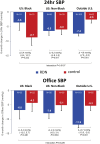Impact of Antihypertensive Medication Changes After Renal Denervation Among Different Patient Groups: SPYRAL HTN-ON MED
- PMID: 38314554
- PMCID: PMC11025607
- DOI: 10.1161/HYPERTENSIONAHA.123.22251
Impact of Antihypertensive Medication Changes After Renal Denervation Among Different Patient Groups: SPYRAL HTN-ON MED
Abstract
Background: The SPYRAL HTN-ON MED (Global Clinical Study of Renal Denervation With the Symplicity Spyral Multi-electrode Renal Denervation System in Patients With Uncontrolled Hypertension in the Absence of Antihypertensive Medications)trial showed significant office and nighttime systolic blood pressure (BP) reductions in patients with hypertension following renal denervation (RDN) compared with sham-control patients, despite similar 24-hour BP reductions. We compared antihypertensive medication and BP changes among prespecified subpopulations.
Methods: The multicenter, randomized, sham-controlled, blinded SPYRAL HTN-ON MED trial (n=337) evaluated BP changes after RDN compared with a sham procedure in patients with hypertension prescribed 1 to 3 antihypertensive drugs. Most patients (n=187; 54%) were enrolled outside the United States, while 156 (46%) US patients were enrolled, including 60 (18%) Black Americans.
Results: Changes in detected antihypertensive drugs were similar between RDN and sham group patients in the outside US cohort, while drug increases were significantly more common in the US sham group compared with the RDN group. Patients from outside the United States showed significant reductions in office and 24-hour mean systolic BP at 6 months compared with the sham group, whereas BP changes were similar between RDN and sham in the US cohort. Within the US patient cohort, Black Americans in the sham control group had significant increases in medication burden from baseline through 6 months (P=0.003) but not in the RDN group (P=0.44).
Conclusions: Patients enrolled outside the United States had minimal antihypertensive medication changes between treatment groups and had significant office and 24-hour BP reductions compared with the sham group. Increased antihypertensive drug burden in the US sham cohort, especially among Black Americans, may have diluted the treatment effect in the combined trial population.
Registration: URL: https://www.clinicaltrials.gov; Unique identifier: NCT02439775.
Keywords: Black or African American; antihypertensive agents; blood pressure; hypertension; renal denervation.
Conflict of interest statement
Figures





Similar articles
-
Long-Term Safety and Efficacy of Renal Denervation: 24-Month Results From the SPYRAL HTN-ON MED Trial.Circ Cardiovasc Interv. 2025 Jul;18(7):e015194. doi: 10.1161/CIRCINTERVENTIONS.125.015194. Epub 2025 May 20. Circ Cardiovasc Interv. 2025. PMID: 40391448 Free PMC article. Clinical Trial.
-
Safety and Efficacy of Renal Denervation in Patients Taking Antihypertensive Medications.J Am Coll Cardiol. 2023 Nov 7;82(19):1809-1823. doi: 10.1016/j.jacc.2023.08.045. J Am Coll Cardiol. 2023. PMID: 37914510 Clinical Trial.
-
Long-term efficacy and safety of renal denervation in the presence of antihypertensive drugs (SPYRAL HTN-ON MED): a randomised, sham-controlled trial.Lancet. 2022 Apr 9;399(10333):1401-1410. doi: 10.1016/S0140-6736(22)00455-X. Epub 2022 Apr 4. Lancet. 2022. PMID: 35390320 Clinical Trial.
-
Renal Denervation for Treating Hypertension: Current Scientific and Clinical Evidence.JACC Cardiovasc Interv. 2019 Jun 24;12(12):1095-1105. doi: 10.1016/j.jcin.2019.02.050. JACC Cardiovasc Interv. 2019. PMID: 31221299 Review.
-
The SPYRAL HTN Global Clinical Trial Program: Rationale and design for studies of renal denervation in the absence (SPYRAL HTN OFF-MED) and presence (SPYRAL HTN ON-MED) of antihypertensive medications.Am Heart J. 2016 Jan;171(1):82-91. doi: 10.1016/j.ahj.2015.08.021. Epub 2015 Sep 11. Am Heart J. 2016. PMID: 26699604 Review.
Cited by
-
Consensus statement on renal denervation by the Joint Committee of Japanese Society of Hypertension (JSH), Japanese Association of Cardiovascular Intervention and Therapeutics (CVIT), and the Japanese Circulation Society (JCS).Cardiovasc Interv Ther. 2024 Oct;39(4):376-385. doi: 10.1007/s12928-024-01017-1. Epub 2024 Jul 30. Cardiovasc Interv Ther. 2024. PMID: 39080214 Free PMC article.
-
Renal denervation up-to-date 2024: evidence and perspectives in Japan.Hypertens Res. 2024 Oct;47(10):2621-2623. doi: 10.1038/s41440-024-01836-y. Epub 2024 Oct 7. Hypertens Res. 2024. PMID: 39370501 No abstract available.
-
Tackling the Disproportionate Burden of Resistant Hypertension in US Black Adults.Curr Cardiol Rep. 2024 Nov;26(11):1163-1171. doi: 10.1007/s11886-024-02115-5. Epub 2024 Sep 5. Curr Cardiol Rep. 2024. PMID: 39235728 Free PMC article. Review.
-
In these cases, I treat hypertension with renal ablation.Eur Heart J Suppl. 2025 Apr 16;27(Suppl 3):iii32-iii35. doi: 10.1093/eurheartjsupp/suaf012. eCollection 2025 Mar. Eur Heart J Suppl. 2025. PMID: 40248286 Free PMC article.
-
Renal denervation for hypertension.Nat Rev Cardiol. 2025 Sep;22(9):664-674. doi: 10.1038/s41569-024-01104-z. Epub 2025 Jan 2. Nat Rev Cardiol. 2025. PMID: 39743561 Review.
References
-
- Zhou B, Carrillo-Larco RM, Danaei G, Riley LM, Paciorek CJ, Stevens GA, Gregg EW, Bennett JE, Solomon B, Singleton RK, et al. . Worldwide trends in hypertension prevalence and progress in treatment and control from 1990 to 2019: a pooled analysis of 1201 population-representative studies with 104 million participants. Lancet. 2021;398:957–980. doi: 10.1016/S0140-6736(21)01330-1 - PMC - PubMed
-
- Virani SS, Alonso A, Benjamin EJ, Bittencourt MS, Callaway CW, Carson AP, Chamberlain AM, Chang AR, Cheng S, Delling FN, et al. . Heart disease and stroke statistics—2020 update: a report from the American Heart Association. Circulation. 2020;141:e139–e596. doi: 10.1161/CIR.0000000000000757 - PubMed
Publication types
MeSH terms
Substances
Associated data
LinkOut - more resources
Full Text Sources
Medical
Miscellaneous

